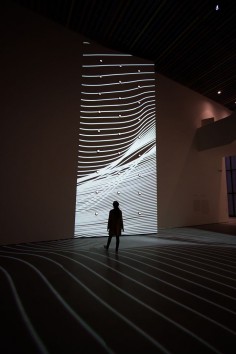Yang Minha
Intervention, Misalignment
source: 21dish
엇갈린 결, 개입
장소는 어떻게 사건과 상황에 적응하는가? 시간–장소–사건으로 만들어지는 역사의 결은 항상 고르게 형평성을 이루는가? 장소는 때로 그 이전의 맥락과는 무관하게 급격히 변화하기도 한다. 종친부, 병원, 기무사에서 미술관까지 맥락과 무관하게 변화된 기능 또한 서울관이라는 장소에 이합집산의 또 다른 결을 만들어낸다. “엇갈린 결, 개입”은 자연스러운 흐름에 개입된 의도적인 변화 요소들을 통해 장소와 공간이 어떻게 적응하는지 실험하는 작업이다.
작가는 장소가 가지는 역사적 맥락을 “결”로 접근한다. 시간의 흐름에 따라 생장하는 거목처럼 장소는 적응하고 성장하기를 멈추지 않는다. 급격한 변화를 통해 엇갈리고 뒤틀리면서도 다시 본디의 흐름을 찾아 결을 쌓아가는 모습이 복잡한 한국 근현대사의 서울-도심이 갖는 본질이다.
개인은 장소에 개입할 수 있는가? 개개인의 개입을 통해 장소가 갖는 결은 잠깐의 파장으로 흔들림을 만들기도 하고, 본디의 모습에 변형을 가하기도 한다. 작가는 9미터 높이의 날카로운 예각의 구조물을 통해 장소를 상징하는 구조물을 설치한다. 구조물은 엇갈리고 뒤틀리는 사건의 개입으로 만들어진 현재의 서울의 속성을 대변한다.
백색의 구조물 표피와 바닥에 투사된 영상은 구조물의 외벽과 바닥을 타고 끊임없이 흘러 바닥의 틈으로 빨려 들어가며, 투사된 영상을 통해 관람객 개인의 개입이 이루어진다. 관람객은 일정한 빛의 흐름에 파문을 만들어 새로운 사건을 더해가며, 그 개입으로 인해 구조물의 내부에 다시 영향을 미친다.
.
.
.
.
.
.
.
source: vimeo
l found the motive for this work from the site of MMCA Seoul, which is the former location of many important institutions from Korean history. First, it was Sogyeokseo (Joseon Dynasty government office in charge of Taoist rituals), then Jongchinbu (Office of the Royal Genealogy of the Joseon Dynasty), and then the National Army Hospital. So the site is saturated with various geographical and historical contexts, but in order to develop this motive into a work of art, lneeded to explore the relations between these contexts. This was a challenge, because those previous occupants seemed to be completely severed from one another, and l felt this was done consciously by those in power. lnterestingly, this repetitious merging and parting of severed contexts is not unique to MMCA Seoul, but common to the entire city. So l felt that it could symbolize Seoul, or even Korea. As l saw the possible scope of the symbolism expanding, l had to change my original plans for the work. At first, l had intended to generate linear images from the written characters of various texts related to the site, but l eventually decided to create a simplerform of images. Another interesting point is that it is almost impossible to find any reliable records of this site, and the public records that do exist have all been altered or censored. So l had to modify my initial idea of representing the site through texts. l wanted to go beyond the site-specific concept of the work to create something that could embody the entire city, so l started to see the work as a flow of patterns. l began creating all these layers, and adding more layers of intervention, and then points of connection where the layers of intenvention come together. But the life of this work is in the intervention, so it was natural to make it interactive with the audience. Actually, since the interaction is so conspicuous, l doubt that my intentions for the work can be clearly identified.
lf you want to use the term “technical” to talk about the production of the work, the main features are motion vector fields, networks, and records. The work responds sensitively to the movements of the viewers. There are two infrared cameras that record people’s movements and use them to produce physical motion vector fields. Then those fields are used to automatically alter the patterns of the lines. Basically, the movements of the audience create motion vector fields for each frame, which are sent from the cameras to a computer that controls the main projector on the wall. The computer translates that input data into figures that are transmitted to the LED equipment on the wall, which create the patterns. The figures are also saved in the computer as XML code. l think this series of overly complicated and sophisticated procedures is actually a perfect representation of the geographical and historical context of MMCA Seoul, and the entire city of Seoul.
2013.11 Intervention, Misalignment / Unfold & Connect / National Museum of Contemporary Art


